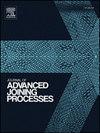Heat treatment optimisation of 18 % Ni maraging steel produced by DED-ARC for enhancing mechanical properties
IF 4
Q2 MATERIALS SCIENCE, MULTIDISCIPLINARY
引用次数: 0
Abstract
This article deals with the Directed Energy Deposition using Wire and Arc (DED-ARC) for maraging steel cladding. A technology for cladding using Gas Metal Arc Welding (GMAW) has been developed that enables the perfect deposition of maraging steel. The material characterisation was carried out in different material states: in the as-built, solution annealed and aged. The research included visual examinations, optical microscopy, Scanning Electron Microscopy / Energy-dispersive X-ray spectroscopy (SEM/EDS), fractography, hardness testing, tensile testing and impact toughness testing. The as-deposited state exhibited a microstructure with very long crystal grains and microsegregations orientated the direction of the heat sink, consisting of lath martensite. Consequently, a subsequent heat treatment is absolutely necessary in order to obtain a uniform fine-grained microstructure. Two different solution annealing processes were analysed, which allowed us to select the most suitable process for the first step of heat treatment followed by aging. A response surface methodology was used to optimise the aging conditions. The results show that additively manufactured maraging steel reaches a tensile strength of 1947 MPa, a hardness of 657 HV5 and a Charpy impact toughness of 11 J at peak aging condition, which is comparable to conventionally manufactured maraging steel.
为提高机械性能,对氩弧焊18% Ni马氏体时效钢进行热处理优化
本文研究了金属丝电弧定向能沉积法(ed - Arc)在马氏体时效钢包层中的应用。研究了一种采用气体保护金属弧焊(GMAW)的熔覆技术,使马氏体时效钢得到完美的熔覆。在不同的材料状态下进行了材料表征:在建成时,溶液退火和时效。研究包括目视检查、光学显微镜、扫描电子显微镜/能量色散x射线能谱(SEM/EDS)、断口分析、硬度测试、拉伸测试和冲击韧性测试。沉积态的显微组织为板条马氏体,晶粒极长,微偏析取向于热沉方向。因此,为了获得均匀的细晶组织,随后的热处理是绝对必要的。分析了两种不同的固溶退火工艺,从而选择了最合适的工艺进行第一步热处理,然后进行时效处理。采用响应面法对老化条件进行优化。结果表明:在峰值时效状态下,添加剂制备的马氏体时效钢的抗拉强度为1947 MPa,硬度为657 HV5,夏比冲击韧性为11 J,与常规制备的马氏体时效钢相当。
本文章由计算机程序翻译,如有差异,请以英文原文为准。
求助全文
约1分钟内获得全文
求助全文

 求助内容:
求助内容: 应助结果提醒方式:
应助结果提醒方式:


